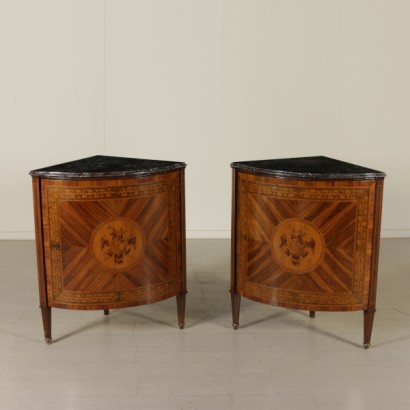Pair of Corner Cabinets
Features
Style: Neo-Classical (1765-1790)
Age: 18th Century / 1701 - 1800
Year: Ultimo quarto del XVIII sec.
Origin: Italy
Main essence: Brazilian Rosewood
Material: Veneer
Description
A pair of late 18th Century Neoclassical Italian corner cabinets with bent front, made of one door, breccia top, truncated conical feet. Rosewood veneer, central coat of arms with crowned eagle, containing other two coat of arms (Imperial family and crowned eagle in yellow band) and Invrea castle, representing the wedding between the two families, framed by an inlaid oak decoration. The frame on the door is inlaid with vine branches decorations. Brass, tips, pine interiors. Manufactured in Genova.
Dimensions (cm):
Height: 100
Width: 88
Depth: 61
Additional Information
Notes historical bibliographic
The furniture described are inserted in the Genoese production in the last quarter of the 18th century. not only for the presence of arms but also for some typical characteristics, the wood used and the inlay, engraved in Burin, typically all details described in the main text of the Cabinet. The two coats of arms lead to marriage to Giulia Invrea (father Marquis Ippolito Septimius) and the Marquis Luigi Lercari, Michael Gallagher and Imperial Senator of the Republic of Genoa (6/7/1736, 6/4/1822), on 4/24/1777. Literature Library: Lodovico Caumont Caimi, The Genoese, and Cabinet making. P.P.S. 1995-Alvar Gonzalez-Palacios, the mobile in Liguria, ed. Sagep 1996Style: Neo-Classical (1765-1790)
This historical period includes a first phase that can be properly defined as the Louis XVI style.nOnly at a later time, with the maturation of archaeological fashions, was a new vision of furnishing civilization formulated and codified, now fully attributable to the Neoclassical Style.
In fact, both trends coexisted in unison until the last years of the eighteenth century.
nIn the field of cabinet making, the Directoire, Retour d'Egypte, Consular and Empire styles also fall within the neoclassical era.
nFind out more about Neoclassicism with the insights from our blog...
n

























